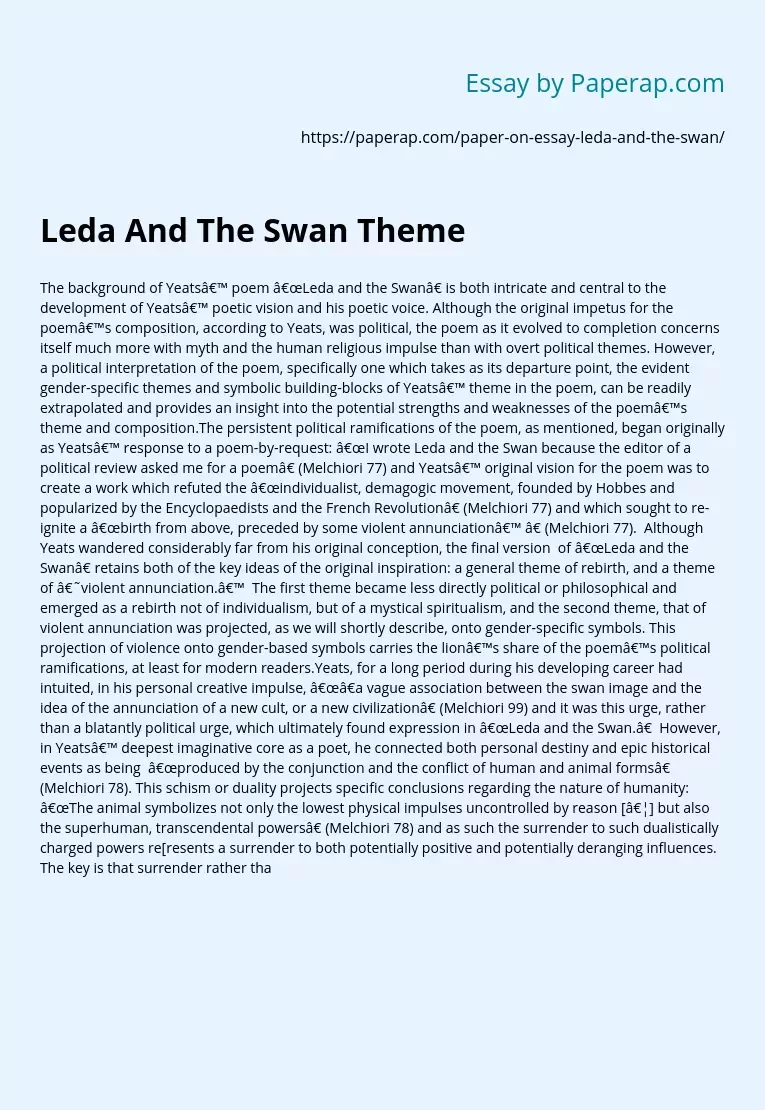Background to Yeats' Poem Leda and the Swan
The following sample essay talks about the backstory of Yeats’ poem Leda and the Swan. Read the introduction, body and conclusion of the essay, scroll down.
The background of Yeats’ poem “Leda and the Swan” is both intricate and central to the development of Yeats’ poetic vision and his poetic voice. Although the original impetus for the poem’s composition, according to Yeats, was political, the poem as it evolved to completion concerns itself much more with myth and the human religious impulse than with overt political themes.
However, a political interpretation of the poem, specifically one which takes as its departure point, the evident gender-specific themes and symbolic building-blocks of Yeats’ theme in the poem, can be readily extrapolated and provides an insight into the potential strengths and weaknesses of the poem’s theme and composition.The persistent political ramifications of the poem, as mentioned, began originally as Yeats’ response to a poem-by-request: “I wrote Leda and the Swan because the editor of a political review asked me for a poem” (Melchiori 77) and Yeats’ original vision for the poem was to create a work which refuted the “individualist, demagogic movement, founded by Hobbes and popularized by the Encyclopaedists and the French Revolution” (Melchiori 77) and which sought to re-ignite a “birth from above, preceded by some violent annunciation’ ” (Melchiori 77).
Although Yeats wandered considerably far from his original conception, the final version of “Leda and the Swan” retains both of the key ideas of the original inspiration: a general theme of rebirth, and a theme of ‘violent annunciation.
’ The first theme became less directly political or philosophical and emerged as a rebirth not of individualism, but of a mystical spiritualism, and the second theme, that of violent annunciation was projected, as we will shortly describe, onto gender-specific symbols. This projection of violence onto gender-based symbols carries the lion’s share of the poem’s political ramifications, at least for modern readers.Yeats, for a long period during his developing career had intuited, in his personal creative impulse, “”a vague association between the swan image and the idea of the annunciation of a new cult, or a new civilization” (Melchiori 99) and it was this urge, rather than a blatantly political urge, which ultimately found expression in “Leda and the Swan.”
However, in Yeats’ deepest imaginative core as a poet, he connected both personal destiny and epic historical events as being “produced by the conjunction and the conflict of human and animal forms” (Melchiori 78). This schism or duality projects specific conclusions regarding the nature of humanity: “The animal symbolizes not only the lowest physical impulses uncontrolled by reason […] but also the superhuman, transcendental powers” (Melchiori 78) and as such the surrender to such dualistically charged powers re[resents a surrender to both potentially positive and potentially deranging influences. The key is that surrender rather than integration or harmonic convergence is indicated; violence is indicated, which in turn demands that there be a target for violence to be acted upon.Not surprisingly, Yeats’ inclination to rely upon the Leda and the Swan myth to find a scaffolding for his poem demanded that he adopt an overtly misogynistic point of view as the myth itself intrinsically deals with rape as an agency of rebirth adn empowerment.
Had Yeats chosen to express the myth ironically through a modern viewpoint which took into account the genuine socio-political ramifications and consequences of rape he might have turned the essentially misogyny of his theme to good purpose and to a political purpose which, in fact, would have served as a new vision of individualism and certainly one which stood in utter opposition to Hobbes. Instead, Yeats embraced the Leda and the Swan myth, rape and all, not only mythically but mystically and in doing so, forwarded a “politically incorrect” theme which can be read as both misogynistic and essentially dismissive of feminine capacity as a passive and incomplete impulse.To the modern reader, lines such as ” A sudden blow: the great wings beating still/Above the staggering girl, her thighs caressed/By the dark webs, her nape caught in his bill,/He holds her helpless breast upon his breast” (Yeats, 1-4) are not apt to signal, even in symbolist connotation, the birth of a new civilization which has been “spawned” by the violent cathartic influence of new myth.
That is what Yeats intended, that the symbols of the poem function as a series of revelations which “announces an advent parallel to the birth of Christianity” (Melchiori 276). Rather, the rape motif of the poem, rendered in such violent lines as:”A shudder in the loins engenders there” (Yeats, 9) or “Being so caught up,/So mastered by the brute blood of the air,” (Yeats, 12-13) is used to forward the quintessential patriarchal ideas of feminine energy (and actual womens’ bodies) being acted upon by force to initiate “rebirth.” This strategy equates women, both at the abstract and concrete level, with utter powerlessness and derives only a single purpose of femininity: that it be acted upon by male energy.In conclusion, because Yeats’ poem does, so explicitely miss the opportunity to re-envision the essentially misogynistic attributes of the Leda and the Swan myth, the poem, by definition, cannot be what Yeats intended it to be — a poem which signaled the poet’s vision of a new age of myth and spiritual understanding. It is very difficult for the modern reader to conceive of any new myth of spiritual awakening on any significant cultural or historical level which did not include the absolutely natural eradication of the very kind of misogyny which forms the central thematic core of Yeats’ celebrated sonnet.
Background to Yeats' Poem Leda and the Swan. (2019, Dec 05). Retrieved from https://paperap.com/paper-on-essay-leda-and-the-swan/

